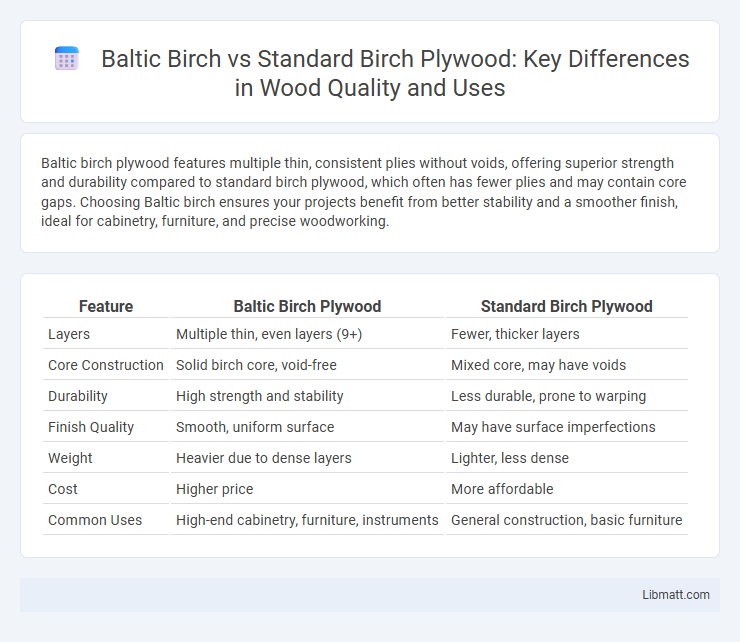Baltic birch plywood features multiple thin, consistent plies without voids, offering superior strength and durability compared to standard birch plywood, which often has fewer plies and may contain core gaps. Choosing Baltic birch ensures your projects benefit from better stability and a smoother finish, ideal for cabinetry, furniture, and precise woodworking.
Table of Comparison
| Feature | Baltic Birch Plywood | Standard Birch Plywood |
|---|---|---|
| Layers | Multiple thin, even layers (9+) | Fewer, thicker layers |
| Core Construction | Solid birch core, void-free | Mixed core, may have voids |
| Durability | High strength and stability | Less durable, prone to warping |
| Finish Quality | Smooth, uniform surface | May have surface imperfections |
| Weight | Heavier due to dense layers | Lighter, less dense |
| Cost | Higher price | More affordable |
| Common Uses | High-end cabinetry, furniture, instruments | General construction, basic furniture |
Overview of Baltic Birch and Standard Birch Plywood
Baltic birch plywood features multiple thin, uniform layers of birch veneer, ensuring exceptional strength, stability, and a smooth surface ideal for precision woodworking and cabinetry. Standard birch plywood generally contains fewer plies with alternating layers of different wood species, resulting in less uniformity and lower structural integrity. Baltic birch's consistent core and high-quality birch veneers make it preferred for applications requiring durability and fine finishing compared to standard birch plywood.
Differences in Manufacturing Processes
Baltic birch plywood is manufactured using multiple thin layers of high-quality birch veneer, usually 13 to 15 plies, bonded with durable hardwood glues under high pressure for enhanced strength and stability. Standard birch plywood typically contains fewer plies, thicker veneers, and may include softwood layers, resulting in less uniformity and reduced strength. Your choice depends on the precision and load-bearing requirements, where Baltic birch offers superior durability and smoother surfaces due to its meticulous cross-grain construction.
Material Composition and Core Structure
Baltic birch plywood features a composition of multiple, thin layers of birch veneer meticulously cross-banded to enhance strength and stability, typically consisting of 13 to 15 plies, compared to standard birch plywood's fewer layers and mixed hardwood cores. The core structure of Baltic birch is uniform and void-free, providing exceptional resistance to warping and superior load-bearing capacity, whereas standard birch plywood often includes a less consistent core with voids or gaps that reduce durability. Your choice of Baltic birch guarantees a premium plywood with unmatched dimensional stability and smooth, high-quality surfaces ideal for precision woodworking projects.
Surface Quality and Appearance
Baltic birch plywood features a consistently smooth, fine-grain surface with multiple thin plies that create a uniform appearance, making it ideal for visible applications and high-end furniture. Standard birch plywood often displays more knots, voids, and inconsistencies in the veneer layers, leading to a less refined and more variable surface quality. The superior face quality of Baltic birch ensures better adhesion for paint and finishes, enhancing its aesthetic appeal compared to standard birch plywood.
Strength and Durability Comparison
Baltic birch plywood offers superior strength and durability compared to standard birch plywood due to its multi-layer core consisting of consistent, cross-banded veneers with no gaps or voids, enhancing load-bearing capacity and resistance to warping. Standard birch plywood often contains fewer plies and visible voids, making it less stable under stress and more prone to delamination over time. The dense construction of Baltic birch results in higher impact resistance, making it ideal for applications requiring robust performance and long-term durability.
Workability and Machining Performance
Baltic birch plywood offers superior workability and machining performance due to its consistent, multi-ply construction and minimal voids, enabling smoother cuts and precise detailing. Standard birch plywood often contains more voids and variable ply thickness, which can lead to splintering and reduced edge quality during machining. Your projects benefit from Baltic birch's uniform density and stability, ensuring cleaner cuts and better holding strength for fasteners and finishes.
Moisture Resistance and Stability
Baltic birch plywood offers superior moisture resistance compared to standard birch plywood due to its multiple, evenly spaced veneers and high-quality adhesive that reduce water absorption and minimize warping. Its consistent cross-grain construction enhances dimensional stability, making it less prone to swelling and delamination under humid conditions. Standard birch plywood has fewer plies and less uniform layering, which can lead to decreased stability and increased vulnerability to moisture damage over time.
Cost Analysis and Availability
Baltic birch plywood generally commands a higher price than standard birch plywood due to its superior multi-ply construction and consistent inner plies, making it more durable and stable for precise woodworking projects. Availability of Baltic birch can be more limited, typically sourced from Northern Europe and found mostly through specialty woodworking suppliers, whereas standard birch plywood is more widely distributed and available at most general lumberyards and home improvement stores. The cost difference reflects not only material quality but also manufacturing precision, influencing overall project budgets and procurement timelines.
Typical Uses and Applications
Baltic birch plywood is favored for cabinetry, furniture making, and precision woodworking due to its uniform layers and superior strength, providing smooth surfaces ideal for staining and finishing. Standard birch plywood is commonly used for general construction, subflooring, and sheathing where cost-effectiveness and moderate durability suffice. Your choice depends on whether you prioritize structural performance and appearance or budget and basic functionality.
Choosing the Right Plywood for Your Project
Baltic birch plywood offers superior strength, durability, and a consistent multi-ply construction with void-free cores, making it ideal for high-quality cabinetry and furniture projects. Standard birch plywood, while more affordable, often contains core voids and fewer plies, which can compromise stability and finish quality in precision work. Choosing Baltic birch ensures your project benefits from enhanced structural integrity and smooth surfaces, providing a professional and long-lasting result.
Baltic birch vs standard birch plywood Infographic

 libmatt.com
libmatt.com